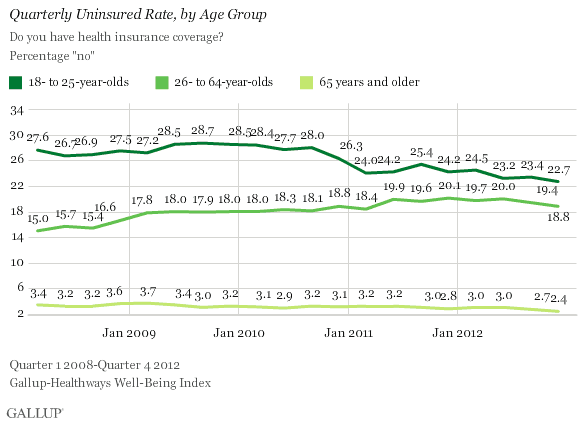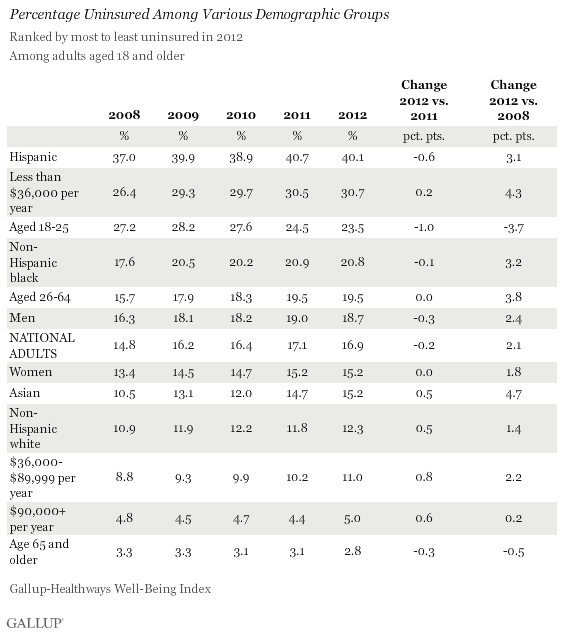WASHINGTON, D.C. -- In the fourth quarter of 2012, 22.7% of Americans aged 18 to 25 reported having no health insurance, down from 24.5% in the first quarter of 2012 and the lowest since Gallup and Healthways started tracking coverage rates daily in January 2008. Uninsured rates for older age groups, however, held fairly steady last year.

The percentage of uninsured young adults has been steadily declining since late 2010, which is when the health law provision allowing Americans up to age 26 to stay on their parents' plans went into effect. The 22.7% who were uninsured in the fourth quarter of 2012 is down six percentage points from the high of 28.7% found in the third quarter of 2009.
Those aged 26 to 64, however, remain more likely to be uninsured than they were in 2008 and 2009. This is likely due to both an increase in unemployment and a reduction in benefits for the employed.
Few seniors continue to be uninsured, with the 2.4% who lacked coverage in the fourth quarter of 2012 on the low end of what Gallup has found. Health insurance coverage in general is easier for seniors to obtain, as the majority of them qualify for Medicare.
Uninsured Rate Still Higher Than in Past, But May Be Coming Down
It appears fewer American adults in general were uninsured towards the end of 2012, with the rate dropping to 16.3% in the fourth quarter -- the lowest it has been in nearly two years. It is still, however, higher than in the past -- in 2008 the uninsured rate for the nation was in the 14% range.

Some of the increases in the percentage of all Americans who were uninsured in Gallup's trend could, in part, reflect changes in Gallup's polling to include more cellphone respondents in its poll samples, specifically in April 2011. Cellphone respondents tend to be younger and are less likely to have health insurance.
Hispanics, Low-Income Remain Most Likely to Be Uninsured
For all of 2012, Hispanics remained the group most likely to be uninsured among major subgroups, at 40.1%. Low-income Americans are the second-most likely to lack coverage, at 30.7%. Behind them are young adults, even despite the downward trend for that group over the past couple years.
Seniors and high-income adults continue to be the least likely to be uninsured, as has been the case since 2008.

Bottom Line
The group that seems most impacted by the Affordable Care Act so far continues to be young adults. No other demographic or socioeconomic group appears to be experiencing significant changes as of yet. However, with 2014 -- the year the individual mandate and health insurance exchanges go into full effect -- fast-approaching, it is likely uninsured rates across all groups will begin to change.
About the Gallup-Healthways Well-Being Index
The Gallup-Healthways Well-Being Index tracks well-being in the U.S. and provides best-in-class solutions for a healthier world. To learn more, please visit well-beingindex.com.
Survey Methods
Results are based on telephone interviews conducted as part of the Gallup-Healthways Well-Being Index survey Oct. 1-Dec. 31, 2012, with a random sample of 830,875 adults, aged 18 and older, living in all 50 U.S. states and the District of Columbia, selected using random-digit-dial sampling.
For results based on the total sample of national adults, one can say with 95% confidence that the maximum margin of sampling error is ±1 percentage point.
Interviews are conducted with respondents on landline telephones and cellular phones, with interviews conducted in Spanish for respondents who are primarily Spanish-speaking. Each sample includes a minimum quota of 400 cellphone respondents and 600 landline respondents per 1,000 national adults, with additional minimum quotas among landline respondents by region. Landline telephone numbers are chosen at random among listed telephone numbers. Cellphone numbers are selected using random-digit-dial methods. Landline respondents are chosen at random within each household on the basis of which member had the most recent birthday.
Samples are weighted by gender, age, race, Hispanic ethnicity, education, region, adults in the household, and phone status (cellphone only/landline only/both, cellphone mostly, and having an unlisted landline number). Demographic weighting targets are based on the March 2011 Current Population Survey figures for the aged 18 and older non-institutionalized population living in U.S. telephone households. All reported margins of sampling error include the computed design effects for weighting and sample design.
In addition to sampling error, question wording and practical difficulties in conducting surveys can introduce error or bias into the findings of public opinion polls.
For more details on Gallup's polling methodology, visit www.gallup.com.In addition to sampling error, question wording and practical difficulties in conducting surveys can introduce error or bias into the findings of public opinion polls.
For more details on Gallup's polling methodology, visit https://www.gallup.com/.
